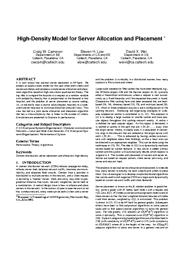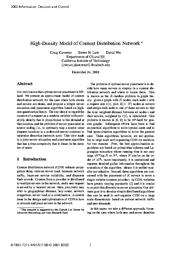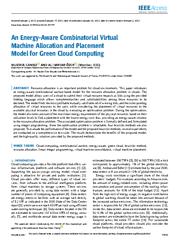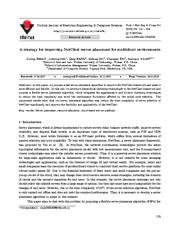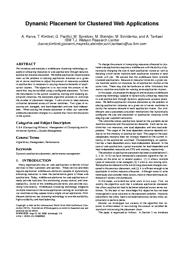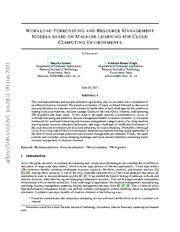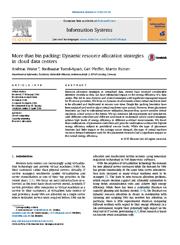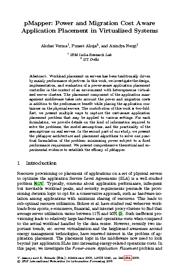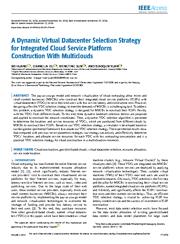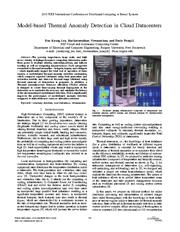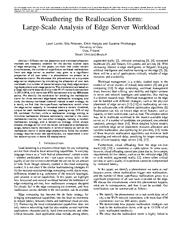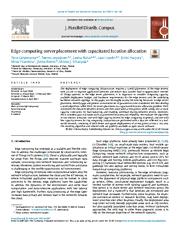A copy of this work was available on the public web and has been preserved in the Wayback Machine. The capture dates from 2006; you can also visit the original URL.
The file type is application/pdf.
Filters
High-density model for server allocation and placement
2002
Proceedings of the 2002 ACM SIGMETRICS international conference on Measurement and modeling of computer systems - SIGMETRICS '02
We present an approximate model for the case when both clients and servers are dense, and propose a simple server allocation and placement algorithm based on high-rate vector quantization theory. ...
The key idea is to regard the location of a request as a random variable with probability density that is proportional to the demand at that location, and the problem of server placement as source coding ...
We are grateful to Michelle Effros, Vangelis Markakis and Vijay V. Vazirani for helpful discussions. ...
doi:10.1145/511334.511354
dblp:conf/sigmetrics/CameronLW02
fatcat:2eqbs4m7efdrnbqwznmmtlpnaq
High-density model for server allocation and placement
2002
Proceedings of the 2002 ACM SIGMETRICS international conference on Measurement and modeling of computer systems - SIGMETRICS '02
We present an approximate model for the case when both clients and servers are dense, and propose a simple server allocation and placement algorithm based on high-rate vector quantization theory. ...
The key idea is to regard the location of a request as a random variable with probability density that is proportional to the demand at that location, and the problem of server placement as source coding ...
We are grateful to Michelle Effros, Vangelis Markakis and Vijay V. Vazirani for helpful discussions. ...
doi:10.1145/511353.511354
fatcat:xgsshoxpq5bnlppuiwkvb72ygi
High-density model for server allocation and placement
2002
Performance Evaluation Review
We present an approximate model for the case when both clients and servers are dense, and propose a simple server allocation and placement algorithm based on high-rate vector quantization theory. ...
The key idea is to regard the location of a request as a random variable with probability density that is proportional to the demand at that location, and the problem of server placement as source coding ...
We are grateful to Michelle Effros, Vangelis Markakis and Vijay V. Vazirani for helpful discussions. ...
doi:10.1145/511399.511354
fatcat:tcxyxlhmond33hykphewxirzui
High-density model of content distribution network
2002
Final Program and Abstracts on Information, Decision and Control
We present an approximate model of content distribution network for the case when both clients and servers are dense, and propose a simple server allocation and placement algorithm based on highrate quantization ...
This view leads to a joint server allocation and placement algorithm that has a time-complexity that is linear in the number of users. * This research is supported by the Caltech Lee Center for Advanced ...
We now apply the techniques of high-rate vector quantization [4, Chapter 5] to derive a server allocation and placement algorithm. ...
doi:10.1109/idc.2002.995378
fatcat:tdtyxicfvrgu5nljtu6c5ospmy
An Energy-Aware Combinatorial Virtual Machine Allocation and Placement Model for Green Cloud Computing
2021
IEEE Access
Resource allocation is an important problem for cloud environments. This paper introduces an energy-aware combinatorial auction-based model for the resource allocation problem in clouds. ...
The results demonstrate the benefits of the proposed model, and the high-quality solutions provided by the proposed methods. ...
ACKNOWLEDGMENT The authors would like to thank the reviewers for their helpful comments that have helped to improve the paper. ...
doi:10.1109/access.2021.3054559
fatcat:suvnn3bjuvatxk4kw2mt5bhieu
A strategy for improving NetClust server placement for multicloud environments
2018
Turkish Journal of Electrical Engineering and Computer Sciences
In this paper, we propose a fast server placement algorithm to improve the NetClust framework and make it more efficient and flexible. ...
The experiment results show that our server placement algorithm may reduce the time complexity of server selection of NetClust significantly and improve the flexibility and applicability of the NetClust ...
It is also supported by the Top Discipline of Library, Information and Data Science in Ministry of Education of the Peoples' Republic of China. ...
doi:10.3906/elk-1704-206
fatcat:xnwbxpiiwzgxhpznqd2glxx2ni
Dynamic placement for clustered web applications
2006
Proceedings of the 15th international conference on World Wide Web - WWW '06
We introduce and evaluate a middleware clustering technology capable of allocating resources to web applications through dynamic application instance placement. ...
It also strives to keep resource utilization balanced across all server machines. Two types of resources are managed, one load-dependent and one load-independent. ...
It is not wise to load applications with high density on a low density server, since we would be likely to reach the processing capacity constraint and leave a lot of memory unused on that server. ...
doi:10.1145/1135777.1135865
dblp:conf/www/KarveKPSSST06
fatcat:szogihzojvgafdcmf5zh4k5i24
workload forecasting and resource management models based on machine learning for cloud computing environments
[article]
2021
arXiv
pre-print
A conceptual framework for workload forecasting and resource management, categorization of existing machine learning based resources allocation techniques, and major challenges of inefficient distribution ...
In this context, the paper presents a comprehensive survey of workload forecasting and predictive resource management models in cloud environment. ...
Though the LSTM-RNN model learns long-term dependencies and produce high accuracy for prediction of server loads, it suffer from long computation time during training due to usage of Back-propagation algorithm ...
arXiv:2106.15112v1
fatcat:cngak4jdvzhjlpfa4jibfne23m
More than bin packing: Dynamic resource allocation strategies in cloud data centers
2015
Information Systems
We focus on dynamic environments where virtual machines need to be allocated and deallocated to servers over time. ...
While the type of placement heuristic had little impact on the average server demand, the type of virtual machine resource demand estimator used for the placement decisions had a significant impact on ...
If the placement decisions were based on the actual demand on a server rather than the reservations for the VMs on a server, the density of the packing could be increased and therefore also the energy ...
doi:10.1016/j.is.2015.03.003
fatcat:ftiwnjjrjfbnhen7ptpku6xatu
pMapper: Power and Migration Cost Aware Application Placement in Virtualized Systems
[chapter]
2008
Lecture Notes in Computer Science
For each formulation, we provide details on the kind of information required to solve the problems, the model assumptions, and the practicality of the assumptions on real servers. ...
Workload placement on servers has been traditionally driven by mainly performance objectives. ...
on the power model for the server. ...
doi:10.1007/978-3-540-89856-6_13
fatcat:j57ly5c33vfvdc4tnfraq5w2oy
A Dynamic Virtual Datacenter Selection Strategy for Integrated Cloud Service Platform Construction with Multiclouds
2019
IEEE Access
The experimental results show that compared with previous server placement strategies, our strategy can actively and effectively determine VDCs' locations and allocate service resources for each VDC with ...
The pay-as-you-go model and network virtualization of cloud computing allow micro and small content businesses (MSCBs) who construct their integrated cloud service platforms (ICSPs) with virtual datacenters ...
Xiang et al. focused on server placement and proposed a cluster-based flexible server placement to allocate resources for edge service nodes [10] . ...
doi:10.1109/access.2019.2956169
fatcat:ymdehjzdl5hbrgxjha3vsbs6qu
Model-Based Thermal Anomaly Detection in Cloud Datacenters
2013
2013 IEEE International Conference on Distributed Computing in Sensor Systems
The growing importance, large scale, and high server density of high-performance computing datacenters make them prone to strategic attacks, misconfigurations, and failures (cooling as well as computing ...
TARA significantly improves the performance of model-based anomaly detection compared to state-of-the-art resource allocation schemes. ...
Furthermore, due to their large scale and high server density, the probability of computing and cooling system misconfigurations as well as of cooling equipment and server fan failures is high [2] . ...
doi:10.1109/dcoss.2013.8
dblp:conf/dcoss/LeeVP13
fatcat:krfmkgs3azc7rov5p7hupsxzha
Weathering the Reallocation Storm: Large-Scale Analysis of Edge Server Workload
2021
2021 Joint European Conference on Networks and Communications & 6G Summit (EuCNC/6G Summit)
Efficient service placement and workload allocation methods are necessary enablers for the actively studied topic of edge computing. ...
We showcase this phenomenon on a city-scale edge server deployment by simulating the allocation of user task workloads in a number of scenarios capturing likely edge computing deployments and usage patterns ...
Centennial foundations; and the personal grant for Lauri Lovén on edge-native AI research by the Tauno Tönning foundation. ...
doi:10.1109/eucnc/6gsummit51104.2021.9482593
fatcat:qelv62u4m5cshkc3x2lvhflxuu
When Deep Reinforcement Learning Meets Federated Learning: Intelligent Multi-Timescale Resource Management for Multi-access Edge Computing in 5G Ultra Dense Network
[article]
2020
arXiv
pre-print
The primary objective is to minimize the total offloading delay and network resource usage by jointly optimizing computation offloading, resource allocation and service caching placement. ...
., computation, communication, storage and service resources); ii) low overhead offloading decision making and resource allocation strategies; and iii) privacy and security protection schemes. ...
At last, the controller makes i) joint computation offloading and resource allocation decisions for the edge servers and EDs in a fast timescale and ii) service caching placement strategies for the edge ...
arXiv:2009.10601v1
fatcat:wxika4igsjg65pwu64ted23aqa
Edge computing server placement with capacitated location allocation
2021
Journal of Parallel and Distributed Computing
We then develop a novel algorithm, called PACK, for server placement as a capacitated location-allocation problem. ...
We evaluate the algorithm in two distinct scenarios: one with high capacity servers for edge computing in general, and one with low capacity servers for Fog computing. ...
, Finland and the Technology Industries of Finland ...
doi:10.1016/j.jpdc.2021.03.007
fatcat:azjyi436kfaetess6hcmvbl5ey
« Previous
Showing results 1 — 15 out of 8,420 results

